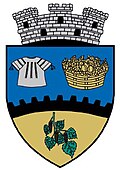Topoloveni
| Topoloveni | ||||
|
||||
| Basic data | ||||
|---|---|---|---|---|
| State : |
|
|||
| Historical region : | Great Wallachia | |||
| Circle : | Argeș | |||
| Coordinates : | 44 ° 48 ' N , 25 ° 5' E | |||
| Time zone : | EET ( UTC +2) | |||
| Height : | 250 m | |||
| Area : | 33.84 km² | |||
| Residents : | 10,219 (October 20, 2011) | |||
| Population density : | 302 inhabitants per km² | |||
| Postal code : | 115500 | |||
| Telephone code : | (+40) 02 48 | |||
| License plate : | AG | |||
| Structure and administration (as of 2016) | ||||
| Community type : | city | |||
| Structure : | 4 districts / cadastral communities: Boțârcani , Crinteşti , Gorăneşti , Țigăneşti | |||
| Mayor : | Gheorghiță Boțârcă ( PSD ) | |||
| Postal address : | Str.Bucureşti, no. 30 loc. Topoloveni, jud. Argeș, RO-115500 |
|||
| Website : | ||||
| Others | ||||
| City Festival : | October 25; "Focul lui Sumedru" ( Sumedrus fire ) | |||
Topoloveni is a Romanian city in Argeș County in Great Wallachia .
Geographical location
Topoloveni is located on the northern edge of the Wallachian Plain , at the transition to the foothills of the Southern Carpathians on the Cârcinov , a left tributary of the Argeș . Topoloveni is located about 20 kilometers east of the district capital Piteşti .
history
Topoloveni was first mentioned in a document in 1421. For a long time it was only a small village that gained importance with the commissioning of the railway from Bucharest to Piteşti in 1872. In 1968 Topoloveni was declared a city. The most important line of business is agriculture; there are also companies in the textile industry and a furniture factory.
population
In 1810 there were only 24 houses in Topoloveni, in which 53 men and 38 women lived. In 1956 the population had grown to 3,904. In the 2002 census, Topoloveni had 10,595 inhabitants, including 10,568 Romanians , 16 Roma and three Magyars . 9009 lived in the actual city, the others in the four cadastral communities.
traffic
Near the city on the Bucharest – Piteşti – Craiova railway line are the Călineşti and Leordeni stations , where only local trains stop. The national road ( drum național ) DN 7 runs through the city ; the Romanian A1 motorway runs about ten kilometers south.
Attractions
- Former hermitage Din Vii , built in 1745, renovated in the 20th century, is a listed building.
- Two churches from the 18th century: Sf. Arhangheli Mihail şi Gavril (1706) and Adormirea Maicii Domnului (1745) are listed monuments.
- Stone crosses (1647 [ La troiță ], 1662, 1712) are a listed building.
Born in Topoloveni
- Ion Mihalache (1882–1963), founder and president of the Peasant Party.
Web links
Individual evidence
- ↑ 2011 census in Romania ( MS Excel ; 1.3 MB)
- ↑ a b Representation of the city of Topoloveni , accessed on May 19, 2019 (multilingual)
- ↑ 2002 census, accessed January 20, 2009
- ↑ a b c List of historical monuments of the Romanian Ministry of Culture, updated 2010 (PDF; 7.10 MB)
- ↑ Angela Harre: Paths to Modernity. Development strategies of Romanian economists in the 19th and 20th centuries (= studies on the social and economic history of East Central Europe. Vol. 18). Harrassowitz, Wiesbaden 2009, ISBN 978-3-447-06003-5 (also: Frankfurt an der Oder, University, dissertation, 2007).


